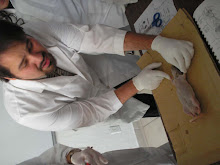Today´s class topic was Nucleic Acids. We already know some things about this topic, since last semester we talk about it.
There are two types of nucleic acids:
-DNA (deoxyribonucleic acid): Formed by 2 strands.
-RNA (ribonucleic acid): Formed by 1 strand.
In DNA the two strands (nucleotides) are joined by hydrocarbons and together with water make them twist, giving the helix form to DNA.
DNA goes through 3 processes: Replication, Transcription and Translation.
This process happens when mitosis happens, because the new cells need of DNA in its nucleus.
In replication what happens is that the helicase gets untwisted and gets separated into 2 strands. When the 2 strands are getting separated small pieces of DNA called primers get stick at the end of hydrocarbons so that the hydrocarbons don´t get back together and form again a double strand. After this, the DNA polymerase this means that then each strand gets a ¨copy¨ and the result are 2 double strands.
http://library.thinkquest.org/
This is part of a semi conservative model since we can say that the resulting DNA has one part of the ¨parent¨ and the other half is a copy, so, it isn´t completely modified or created.
Next, the transcription process takes place in the nucleus and consists of lots of steps, but here they are simplified:
-Iniciation: When the 2 strands start to open.
-Elongation: When the RNA poly opens.
-Finalization: Ending of transcription.
Even it looks like the words are written wrong, they aren´t this are words scientists commonly use.
In transcription, RNA polymerase is needed so that the DNA can turn into RNA.
Finally, translation is when the RNA turns or is translated into proteins.
Stephanie Sotelo

No hay comentarios:
Publicar un comentario